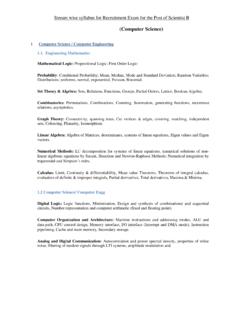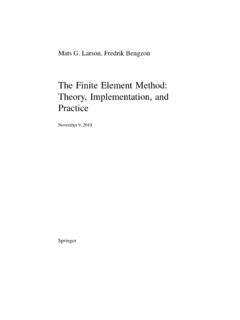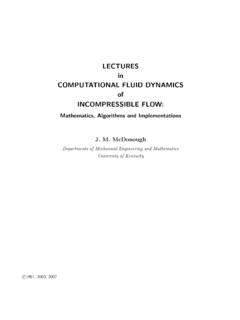Transcription of The Shallow Water Equations - University of Texas at Austin
1 The Shallow Water EquationsClint Dawson and Christopher M. MirabitoInstitute for Computational Engineering and SciencesUniversity of Texas at 29, 2008 IntroductionDerivation of the SWEThe Shallow Water Equations (SWE)What are they?The SWE are a system of hyperbolic/parabolic PDEs governing fluidflow in the oceans (sometimes), coastal regions (usually), estuaries(almost always), rivers and channels (almost always).The general characteristic of Shallow Water flows is that the verticaldimension is much smaller than the typical horizontal scale. In thiscase we can average over the depth to get rid of the SWE can be used to predict tides, storm surge levels andcoastline changes from hurricanes, ocean currents, and to studydredging also arise in atmospheric flows and debris MirabitoThe Shallow Water EquationsIntroductionDerivation of the SWEThe SWE (Cont.)How do they arise?The SWE are derived from theNavier-Stokes Equations , whichdescribe the motion of Navier-Stokes Equations are themselves derived from theequations for conservation of mass and linear MirabitoThe Shallow Water EquationsIntroductionDerivation of the SWED erivation of the Navier-Stokes EquationsBoundary ConditionsSWE Derivation ProcedureThere are 4 basic steps:1 Derive the Navier-Stokes Equations from the conservation average the Navier-Stokes Equations to account for theturbulent nature of ocean flow.
2 See [1, 3, 4] for boundary conditions for the Navier-Stokes Equations for awater the BCs to integrate the Navier-Stokes Equations over our derivation, we follow the presentation given in [1] closely, but wealso use ideas in [2].C. MirabitoThe Shallow Water EquationsIntroductionDerivation of the SWED erivation of the Navier-Stokes EquationsBoundary ConditionsConservation of MassConsider mass balance over a control volume . Thenddt dV Time rate of changeof total mass in = ( v) ndA Net mass flux acrossboundary of ,where is the fluid density (kg/m3),v= uvw is the fluid velocity (m/s), andnis the outward unit normal vector on .C. MirabitoThe Shallow Water EquationsIntroductionDerivation of the SWED erivation of the Navier-Stokes EquationsBoundary ConditionsConservation of Mass: Differential FormApplying Gauss s Theorem givesddt dV= ( v) that is smooth, we can apply the Leibniz integral rule: [ t+ ( v)]dV= is arbitrary, t+ ( v) = 0C.
3 MirabitoThe Shallow Water EquationsIntroductionDerivation of the SWED erivation of the Navier-Stokes EquationsBoundary ConditionsConservation of Linear MomentumNext, consider linear momentum balance over a control volume . Thenddt vdV Time rate ofchange of totalmomentum in = ( v)v ndA Net momentum fluxacross boundary of + bdV Body forcesacting on + TndA External contactforces actingon ,wherebis the body force density per unit mass acting on the fluid (N/kg),andTis the Cauchy stress tensor (N/m2). See [5, 6] for more detailsand an existence MirabitoThe Shallow Water EquationsIntroductionDerivation of the SWED erivation of the Navier-Stokes EquationsBoundary ConditionsConservation of Linear Momentum: Differential FormApplying Gauss s Theorem again (and rearranging) givesddt vdV+ ( vv)dV bdV TdV= vis smooth, we apply the Leibniz integral rule again: [ t( v) + ( vv) b T]dV= is arbitrary, t( v) + ( vv) b T= 0C.
4 MirabitoThe Shallow Water EquationsIntroductionDerivation of the SWED erivation of the Navier-Stokes EquationsBoundary ConditionsConservation Laws: Differential FormCombining the differential forms of the Equations for conservation ofmass and linear momentum, we have: t+ ( v) = 0 t( v) + ( vv) = b+ TTo obtain the Navier-Stokes Equations from these, we need to make someassumptions about our fluid (sea Water ), about the density , and aboutthe body forcesband stress MirabitoThe Shallow Water EquationsIntroductionDerivation of the SWED erivation of the Navier-Stokes EquationsBoundary ConditionsSea Water : Properties and AssumptionsIt is incompressible. This means that does not depend onp. Itdoes not necessarily mean that is constant! In ocean modeling, depends on the salinity and temperature of the sea and temperature are assumed to be constant throughout ourdomain, so we can just take as a constant. So we can simplify theequations: v= 0, t v+ ( vv) = b+ Water is a Newtonian fluid.
5 This affects the form MirabitoThe Shallow Water EquationsIntroductionDerivation of the SWED erivation of the Navier-Stokes EquationsBoundary ConditionsBody Forces and Stresses in the Momentum EquationWe know that gravity is one body force, so b= g+ bothers,wheregis the acceleration due to gravity (m/s2), andbothersare other body forces ( the Coriolis force in rotatingreference frames) (N/kg). We will neglect for a Newtonian fluid,T= pI+ Twherepis the pressure (Pa) and Tis a matrix of stress MirabitoThe Shallow Water EquationsIntroductionDerivation of the SWED erivation of the Navier-Stokes EquationsBoundary ConditionsThe Navier-Stokes EquationsSo our final form of the Navier-Stokes Equations in 3D are: v= 0, t v+ ( vv) = p+ g+ T,C. MirabitoThe Shallow Water EquationsIntroductionDerivation of the SWED erivation of the Navier-Stokes EquationsBoundary ConditionsThe Navier-Stokes EquationsWritten out: u x+ v y+ w z= 0(1) ( u) t+ ( u2) x+ ( uv) y+ ( uw) z= ( xx p) x+ xy y+ xz z(2) ( v) t+ ( uv) x+ ( v2) y+ ( vw) z= xy x+ ( yy p) y+ yz z(3) ( w) t+ ( uw) x+ ( vw) y+ ( w2) z= g+ xz x+ yz y+ ( zz p) z(4)C.
6 MirabitoThe Shallow Water EquationsIntroductionDerivation of the SWED erivation of the Navier-Stokes EquationsBoundary ConditionsA Typical Water Column = (t,x,y) is the elevation (m) of thefree surfacerelative to (x,y) is the bathymetry (m), measured positive downwardfrom the (t,x,y) is the total depth (m) of the Water column. NotethatH= + MirabitoThe Shallow Water EquationsIntroductionDerivation of the SWED erivation of the Navier-Stokes EquationsBoundary ConditionsA Typical Bathymetric ProfileBathymetry of the Atlantic Trench. Image courtesy MirabitoThe Shallow Water EquationsIntroductionDerivation of the SWED erivation of the Navier-Stokes EquationsBoundary ConditionsBoundary ConditionsWe have the following BCs:1At the bottom (z= b)No slip:u=v= 0No normal flow:u b x+v b y+w= 0(5)Bottom shear stress: bx= xx b x+ xy b y+ xz(6)where bxis specified bottom friction (similarly forydirection).2At the free surface (z= )No relative normal flow: t+u x+v y w= 0(7)p= 0 (done in [2])Surface shear stress: sx= xx x xy y+ xz(8)where the surface stress ( wind) sxis specified (similary forydirection).
7 C. MirabitoThe Shallow Water EquationsIntroductionDerivation of the SWED erivation of the Navier-Stokes EquationsBoundary Conditionsz-momentum EquationBefore we integrate over depth, we can examine the momentum equationfor vertical velocity. By a scaling argument, all of the terms except thepressure derivative and the gravity term are thez-momentum equation collapses to p z= gimplying thatp= g( z).This is thehydrostatic pressure distribution. Then p x= g x(9)with similar form for p MirabitoThe Shallow Water EquationsIntroductionDerivation of the SWED erivation of the Navier-Stokes EquationsBoundary ConditionsThe 2D SWE: Continuity EquationWe now integrate thecontinuity equation v= 0 fromz= btoz= . Since bothband depend ont,x, andy, we apply the Leibnizintegral rule:0 = b vdz= b( u x+ v y)dz+w|z= w|z= b= x bu dz+ y bv dz (u|z= x+u|z= b b x) (v|z= y+v|z= b b y)+w|z= w|z= bC. MirabitoThe Shallow Water EquationsIntroductionDerivation of the SWED erivation of the Navier-Stokes EquationsBoundary ConditionsThe Continuity Equation (Cont.)
8 Defining depth-averaged velocities as u=1H bu dz, v=1H bv dz,we can use our BCs to get rid of the boundary terms. So thedepth-averaged continuity equation is H t+ x(H u) + y(H v) = 0(10)C. MirabitoThe Shallow Water EquationsIntroductionDerivation of the SWED erivation of the Navier-Stokes EquationsBoundary ConditionsLHS of thex- andy-Momentum EquationsIf we integrate the left-hand side of thex-momentum equation overdepth, we get: b[ tu+ xu2+ y(uv) + z(uw)]dz= t(H u) + x(H u2) + y(H u v) +{Diff. }(11)The differential advection terms account for the fact that the average ofthe product of two functions is not the product of the get a similar result for the left-hand side of MirabitoThe Shallow Water EquationsIntroductionDerivation of the SWED erivation of the Navier-Stokes EquationsBoundary ConditionsRHS ofx- andy-Momentum EquationsIntegrating over depth gives us{ gH x+ sx bx+ x b xx+ y b xy gH y+ sy by+ x b xy+ y b yy(12)C.}
9 MirabitoThe Shallow Water EquationsIntroductionDerivation of the SWED erivation of the Navier-Stokes EquationsBoundary ConditionsAt long last..Combining the depth-integrated continuity equation with the LHS andRHS of the depth-integratedx- andy-momentum Equations , the 2D(nonlinear) SWE in conservative form are: H t+ x(H u) + y(H v) = 0 t(H u) + x(H u2)+ y(H u v) = gH x+1 [ sx bx+Fx] t(H v) + x(H u v) + y(H v2)= gH y+1 [ sy by+Fy]The surface stress, bottom friction, andFxandFymust still determinedon a case-by-case MirabitoThe Shallow Water EquationsIntroductionDerivation of the SWED erivation of the Navier-Stokes EquationsBoundary ConditionsReferencesC. B. Vreugdenhil: numerical methods for Shallow Water Flow,Boston: Kluwer Academic Publishers (1994)E. J. Kubatko:Development, Implementation, and Verification ofhp-Discontinuous Galerkin Models for Shallow Water Hydrodynamicsand transport , Dissertation (2005)S.
10 B. Pope:Turbulent Flows, Cambridge University Press (2000)J. O. Hinze:Turbulence, 2nded., New York: McGraw-Hill (1975)J. T. Oden:A Short Course on Nonlinear Continuum Mechanics,Course Notes (2006)R. L. Panton:Incompressible Flow, Hoboken, NJ: Wiley (2005)C. MirabitoThe Shallow Water Equations






